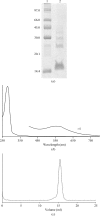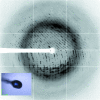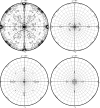Superoxide reductase from Nanoarchaeum equitans: expression, purification, crystallization and preliminary X-ray crystallographic analysis
- PMID: 21543869
- PMCID: PMC3087648
- DOI: 10.1107/S1744309111009432
Superoxide reductase from Nanoarchaeum equitans: expression, purification, crystallization and preliminary X-ray crystallographic analysis
Abstract
Superoxide reductases (SORs) are the most recent oxygen-detoxification system to be identified in anaerobic and microaerobic bacteria and archaea. SORs are metalloproteins that are characterized by their possession of a catalytic nonhaem iron centre in the ferrous form coordinated by four histidine ligands and one cysteine ligand. Ignicoccus hospitalis, a hyperthermophilic crenarchaeon, is the only organism known to date to serve as a host for Nanoarchaeum equitans, a nanosized hyperthermophilic archaeon isolated from a submarine hot vent which completely depends on the presence of and contact with I. hospitalis cells for growth to occur. Similarly to I. hospitalis, N. equitans has a neelaredoxin (a 1Fe-type SOR) that keeps toxic oxygen species under control, catalysing the one-electron reduction of superoxide to hydrogen peroxide. Blue crystals of recombinant N. equitans SOR in the oxidized form (12.7 kDa, 109 residues) were obtained using polyethylene glycol (PEG 2000 MME) as precipitant. These crystals diffracted to 1.9 Å resolution at 100 K and belonged to the orthorhombic space group P2(1)2(1)2(1), with unit-cell parameters a = 51.88, b = 82.01, c = 91.30 Å. Cell-content analysis suggested the presence of four monomers in the asymmetric unit. The Matthews coefficient (V(M)) was determined to be 1.9 Å(3) Da(-1), corresponding to an estimated solvent content of 36%. Self-rotation function and native Patterson calculations suggested a tetramer with 222 point-group symmetry, similar to other 1Fe-SORs. The three-dimensional structure will be determined by the molecular-replacement method.
Figures





Similar articles
-
Cloning, purification, crystallization and X-ray crystallographic analysis of Ignicoccus hospitalis neelaredoxin.Acta Crystallogr Sect F Struct Biol Cryst Commun. 2010 May 1;66(Pt 5):605-7. doi: 10.1107/S1744309110012030. Epub 2010 Apr 30. Acta Crystallogr Sect F Struct Biol Cryst Commun. 2010. PMID: 20445270 Free PMC article.
-
Purification, crystallization and X-ray crystallographic analysis of Archaeoglobus fulgidus neelaredoxin.Acta Crystallogr Sect F Struct Biol Cryst Commun. 2010 Mar 1;66(Pt 3):316-9. doi: 10.1107/S1744309110000916. Epub 2010 Feb 24. Acta Crystallogr Sect F Struct Biol Cryst Commun. 2010. PMID: 20208170 Free PMC article.
-
Insights into the Structures of Superoxide Reductases from the Symbionts Ignicoccus hospitalis and Nanoarchaeum equitans.Biochemistry. 2018 Sep 11;57(36):5271-5281. doi: 10.1021/acs.biochem.8b00334. Epub 2018 Aug 28. Biochemistry. 2018. PMID: 29939726
-
The unusual cell biology of the hyperthermophilic Crenarchaeon Ignicoccus hospitalis.Antonie Van Leeuwenhoek. 2012 Aug;102(2):203-19. doi: 10.1007/s10482-012-9748-5. Epub 2012 Jun 1. Antonie Van Leeuwenhoek. 2012. PMID: 22653377 Review.
-
Happy together: genomic insights into the unique Nanoarchaeum/Ignicoccus association.J Biol. 2009;8(1):7. doi: 10.1186/jbiol110. Epub 2009 Jan 23. J Biol. 2009. PMID: 19216728 Free PMC article. Review.
Cited by
-
Clostridioides difficile superoxide reductase mitigates oxygen sensitivity.J Bacteriol. 2024 Jul 25;206(7):e0017524. doi: 10.1128/jb.00175-24. Epub 2024 Jul 2. J Bacteriol. 2024. PMID: 38953644 Free PMC article.
References
-
- Archer, M., Huber, R., Tavares, P., Moura, I., Moura, J. J., Carrondo, M. A., Sieker, L. C., LeGall, J. & Romão, M. J. (1995). J. Mol. Biol. 251, 690–702. - PubMed
-
- Ausubel, F. M., Brent, R., Kingston, R. E., Moore, D. D., Seidman, J. G., Smith, J. A. & Struhl, K. (1987). Editors. Current Protocols in Molecular Biology. New York: Greene Publishing Associates/Wiley Interscience.
-
- Berthomieu, C., Dupeyrat, F., Fontecave, M., Verméglio, A. & Nivière, V. (2002). Biochemistry, 41, 10360–10368. - PubMed
-
- Diederichs, K. & Karplus, P. A. (1997). Nature Struct. Biol. 4, 269–275. - PubMed
-
- Emerson, J. P., Coulter, E. D., Cabelli, D. E., Phillips, R. S. & Kurtz, D. M. (2002). Biochemistry, 41, 4348–4357. - PubMed
Publication types
MeSH terms
Substances
LinkOut - more resources
Full Text Sources
Miscellaneous

